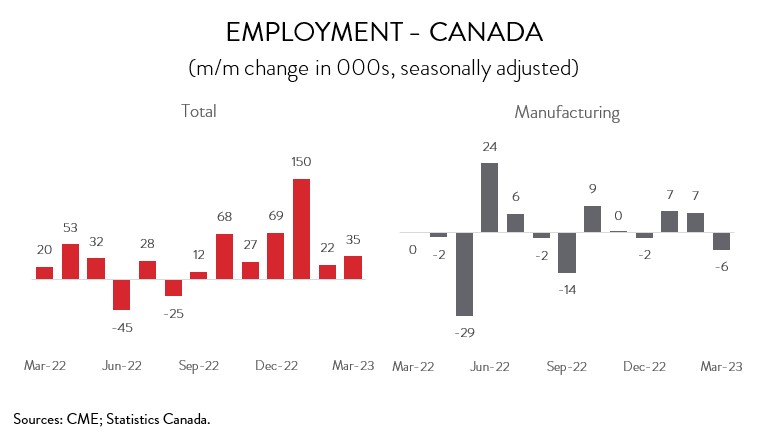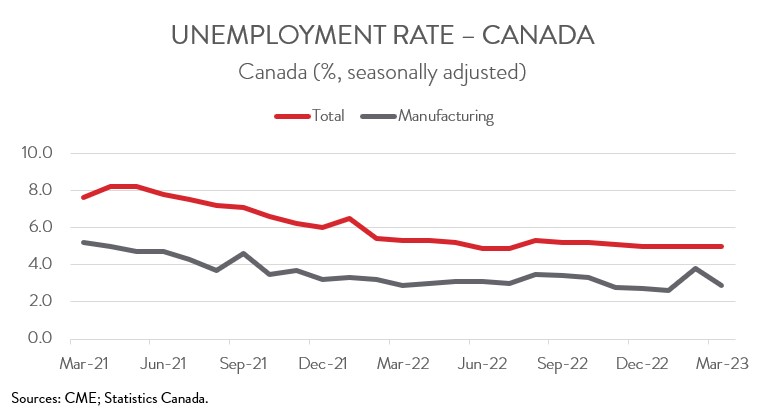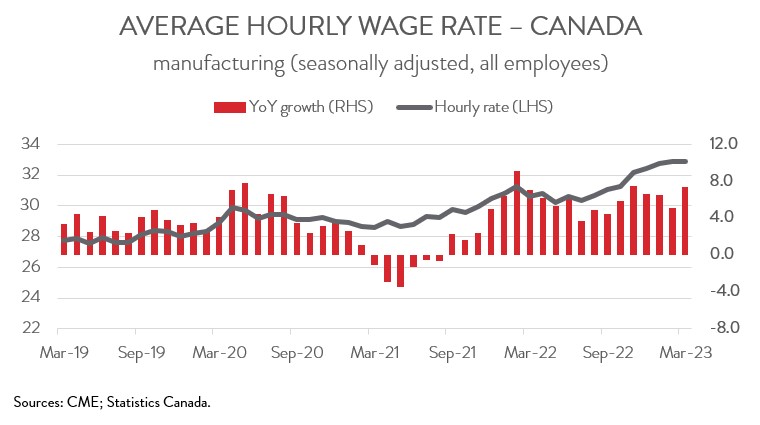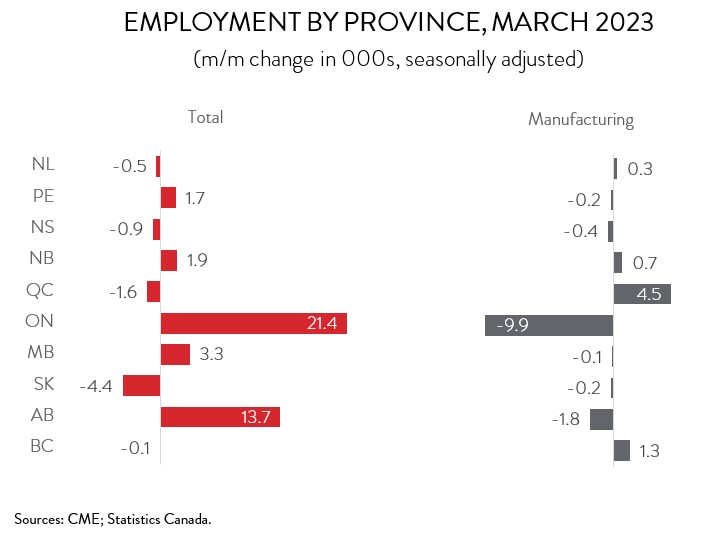Labour Market Trends - March 2023; Sources: CME; Statistics Canada.
No images? Click here
Canadian Economy Churns Out More Jobs in March, Manufacturing Employment Falls
HIGHLIGHTS
- Employment in Canada rose by 34,700 (+0.2%) in March, the seven straight monthly increase.
- Employment was up in 7 of 16 industries, with three seeing significant gains: transportation and warehousing, business, building and other support services, and finance, insurance and real estate.
- Manufacturing employment fell by 6,100 (-0.3%) in March, down for the first time in three months.
- The headline unemployment rate held steady at 5.0% in March, while the unemployment rate in manufacturing fell sharply to 2.9%.
- Year-over-year wage growth in manufacturing remains elevated, accelerating to 7.4% in March.
- Total employment was up in 5 of 10 provinces, led by Ontario, Alberta, and PEI.
- The decrease in manufacturing employment was concentrated in Ontario.
- The Bank of Canada has been rapidly raising interest rates to slow the overheated economy, but the labour market has yet to get the memo. Employment has increased by 382,500 over the past seven months, the unemployment rate sits near a record low, and wage growth remains brisk.
EMPLOYMENT CONTINUES TO CLIMB HIGHER IN MARCH
Employment in Canada increased by 34,700 (+0.2%) in March, the seven consecutive monthly increase. Actual hours worked were up an even stronger 0.4%, a positive sign for GDP growth.

Employment was up in 7 of 16 industries, with three seeing significant gains: transportation and warehousing (+40,600), business, building and other support services (+30,500), and finance, insurance and real estate (+18,500). These increases were partially offset by pullbacks in construction (-18,800), health care and social assistance (-12,800), and natural resources (-10,600).
The Bank of Canada has been rapidly raising interest rates to slow the overheated economy, but the labour market has yet to get the memo. Employment has increased by 382,500 over the past seven months, the unemployment rate sits near a record low, and wage growth remains brisk. While the Bank of Canada is widely expected to keep rates on hold at its next meeting on April 12th, concerns about the tight labour market mean the Bank won’t rule out the possibility that rates might rise further.
MANUFACTURING EMPLOYMENT FALLS
Manufacturing employment fell by 6,100 (-0.3%) in March, down for the first time in three months. In a clear sign that manufacturing activity is softening, the sector has not created any jobs over the past 12 months. Put another way, manufacturing employment stood at 1.793 million in March, matching the year-ago level.
MANUFACTURING UNEMPLOYMENT RATE DROPS SHARPLY
For the fourth consecutive month in March, the headline unemployment rate held steady at 5.0%, remaining just a hair above the record low of 4.9% reached last June and July. In contrast, the jobless rate in manufacturing fell sharply from 3.8% in February to 2.9% in March, only 0.3 percentage points above the all-time low.

WAGE GROWTH IN MANUFACTURING ACCELERATES
Persistently tight labour market conditions continue to drive up wages. Average hourly earnings rose 5.3% on a year-over-year basis in March, down only a touch from 5.4% in February. This pace of growth is inconsistent with getting inflation back to target.
Pay gains are an even bigger issue in manufacturing, even though job growth has been stalling. On a year-over-year basis, wage growth in the sector surged from 5.1% in February to 7.4% in March, the fifth highest increase on record. The average hourly wage rate in manufacturing stood at $32.86 last month.

FIVE PROVINCES RECORD JOB GAINS
Regionally, the employment increase spanned 5 of 10 provinces. The largest absolute gains were recorded in Ontario (+21,400) and Alberta (+13,700), while the largest proportional increase was observed in PEI (+1,700). On the downside, employment in Saskatchewan fell by 4,400, the first notable decline since July 2022.
In the manufacturing sector, employment was down in six provinces in March. The lion’s share of the decrease was registered in Ontario (-9,900), the second straight monthly drop. In proportional terms, noteworthy declines were also observed in PEI (-200), Alberta (-1,800), and Nova Scotia (-400). Quebec was one of the few provinces to buck the trend, with manufacturing employment up a solid 4,500 last month. Over the last year, Alberta’s manufacturers have created the most jobs (+10,700), while BC’s manufacturers have shed the most workers (-17,500).

ABOUT OUR CHIEF ECONOMIST

Alan Arcand
Chief Economist,
Canadian Manufacturers & Exporters
Alan is a member of the National Policy team where he is responsible for developing and executing CME’s major national research projects, conducting CME’s macroeconomic analysis to support the organization across the country, leading our tax policy efforts, and be a leading voice representing the interests of the association and members with government and with the public.
Before joining CME, Alan spent 19 years at The Conference Board of Canada where he held multiple roles, including the Associate Director of the Centre for Municipal Studies. Alan’s background includes expertise in municipal, regional, and national economic matters including economic forecasting and analysis.